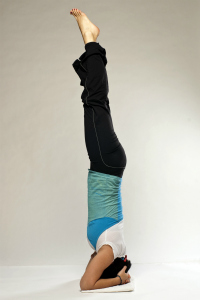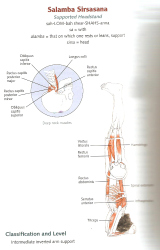In the next series I am going to describe you the 12 basic asanas that we practice in the Sivananda style yoga and that benefit our health the most.
1. SIRSASANA – HEADSTAND
The headstand is regarded as the ‘King’ of the estimated 84000 different asanas. There are eight steps to follow when coming into the pose. To begin start in child’s pose: sit on the heels with forehead on the floor, hands with palms upward, next to the feet. Relax here for few moments and mentally visualise yourself in the headstand.
- from child’s pose sit up on the heels, knees together. Place each hand on the opposite elbow measuring the distance. Bring the elbows to the ground under the shoulders.
- Bring the hands together so that the arms form a tripod on the ground, interlocking the fingers.
- Place the head on the ground with the back of the head against the hands. Raise the hips. Make sure that the elbows are stationary.
- Walk the feet forward towards the head. Keep the hips up and knees straight.
- Bend the knees in towards the chest. Bring the heels up to the buttocks.
- Staighten the back, making sure that the spine retains its natural curve. Be able to balance in this position for 30 seconds before going further.
- Keeping the knees bent and together slowly straighten the hips until the bent knees are pointing towards the ceiling.
- Straighten the knees.
Start with holding for 15 seconds and gradually increase the time. Optimum time is 5-10 minutes on a daily basis.
To come out of the pose, bend the knees, bringing them into the chest. Bend the hips bringing the feet to the floor. Relax in Child’s pose before lifing the head off the ground.
Do not practice the headstand if you:
- Have high blood pressure
- Suffer fron Glaucoma (eye disease)
- Are four or more months pregnant
- Have been advised not to by the doctor
Main benefits of the Headstand
- The heart needs to pump the blood with only enough force for it to reach the toes; gravity will help to return it to the heart
- With regular practice you will tend to have slow rates of respiration and heart beat, which means that your respiratory and circulatory systems are strong and flexible
- Inversion enhances deep breathing – increased oxygen supply to the brain
- Excellent for those who have varicose veins
- Pressure relieved from lower back areas
- Memory and intellectual capacity is increased, improved concentration
The muscles involved are the following:
The picture is from Laslie Kamonoff’s Yoga Anatomy book.



No Comments